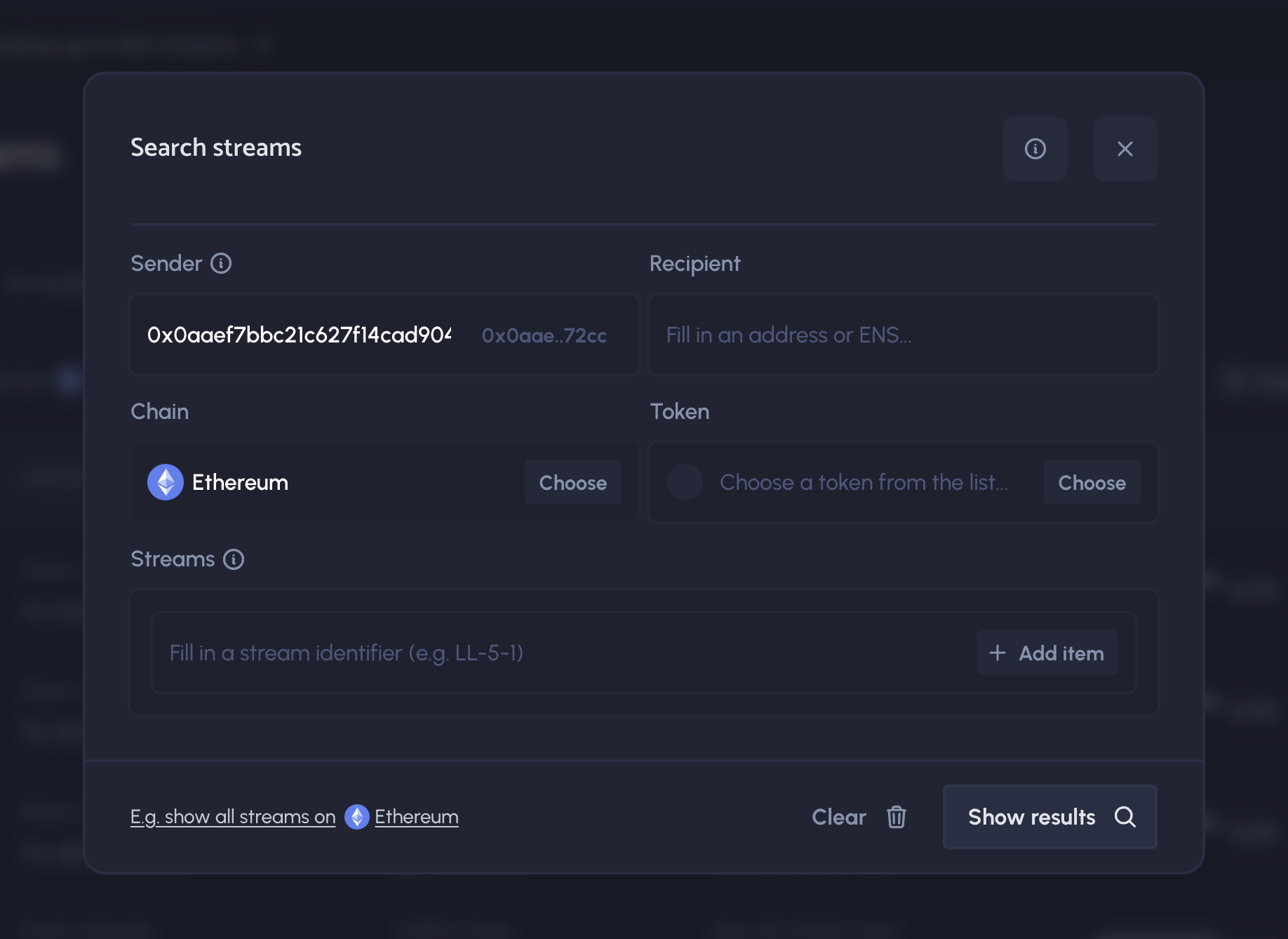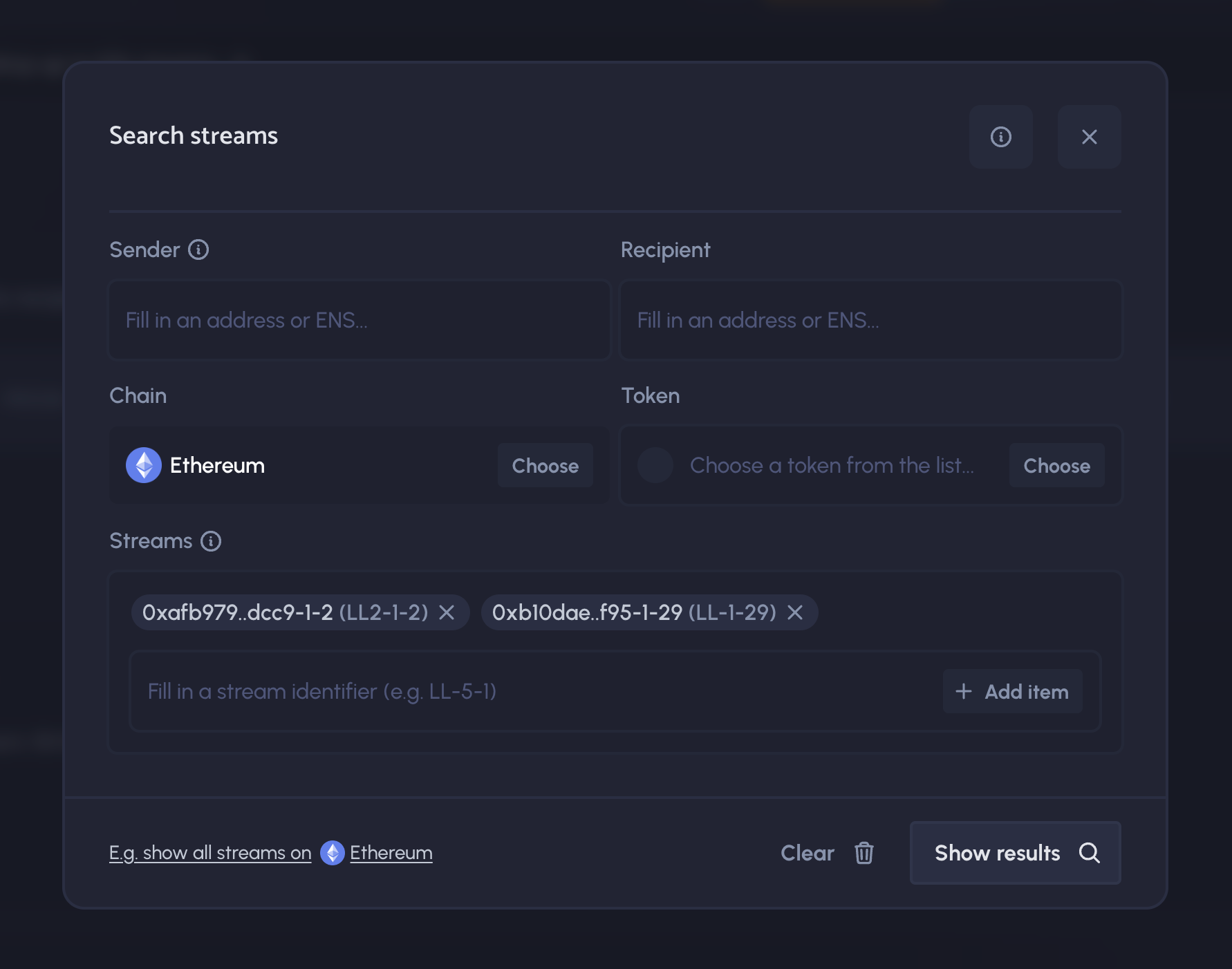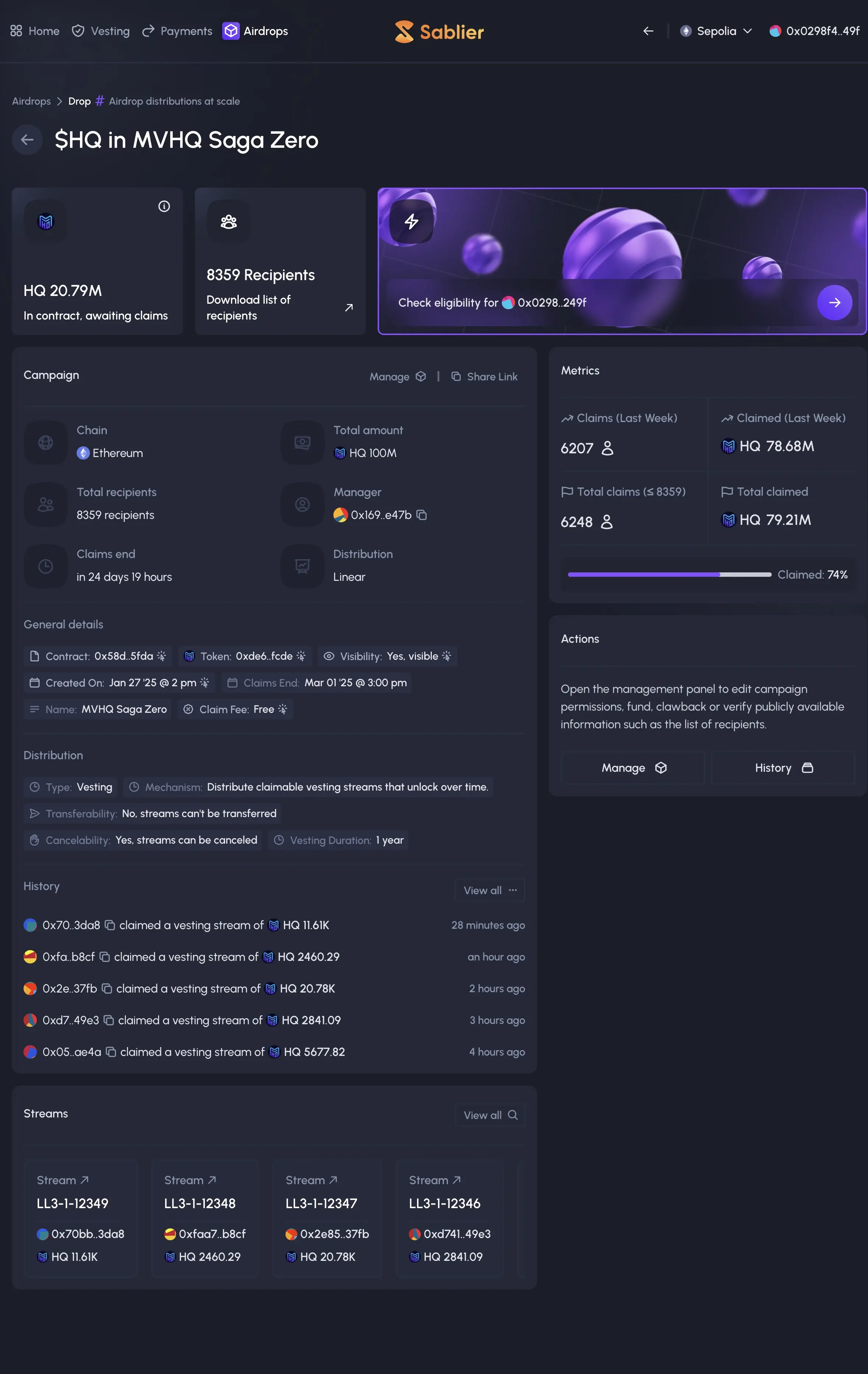URL Schemes
The Sablier Interface makes it easy for integrators to link to specific users or entities. In this guide, we will cover a number of resource locators used by the apps, and dive into how you can use them.
Stream Page
 |
Elements
Every stream created through the Sablier Protocol is identified through three parameters:
- a chainId (e.g.,
1for Ethereum,10for Optimism, etc. ) - an alias (e.g.,
LK) OR a contract (e.g.0x12..AB) - a streamId (generated at stream creation)
Contract Aliases
Sablier supports different token distribution products, e.g. SablierLockup and SablierFlow. To provide a visual
resolver in the UI, we alias the contract addresses with the following abbreviations:
In the past, the functionality of the SablierLockup contract used to be distributed among different contracts.
- Lockup Linear V2.0 contracts become
LL, e.g.LL-137-1 - Lockup Linear V2.1 contracts become
LL2, e.g.LL2-137-1 - Lockup Dynamic V2.0 contracts become
LD, e.g.LD-137-1 - Lockup Dynamic V2.1 contracts become
LD2, e.g.LD2-137-1
Building the URL
By combining the elements described above, you can send users from your interface directly to the create stream page in
the Sablier Interface. To build the link to a stream resource, you use a hyphen - to concatenate the uppercase
contract alias, the chainId, and the streamId, and then you add them to the base URL app.sablier.com/stream/:
| URL | Description |
|---|---|
| app.sablier.com/stream/LL2-137-29 | Lockup Linear V2.1 stream #29 on Polygon |
| app.sablier.com/stream/LL-137-32 | Lockup Linear V2.0 stream #32 on Polygon |
| app.sablier.com/stream/LD-137-13 | Lockup Dynamic V2.0 stream #13 on Polygon |
| app.sablier.com/stream/LL-1-6 | Lockup Linear V2.0 stream #6 on Ethereum |
| app.sablier.com/stream/0xB10...f95-1-6 | Lockup Linear V2.0 stream #6 on Ethereum |
| app.sablier.com/stream/LL2-11155111-40 | Lockup Linear V2.1 stream #40 on Ethereum Sepolia |
As you can see, the main format is contractA-chainId-streamId. This is supported both at the app and the subgraph
level. For situations when an alias cannot be used, we fallback to the following format:
contractAddress-chainId-streamId. Read more about identifiers and aliases in our APIs docs.
Search Streams
Elements
The Sablier Interface comes with an advanced search view that can be accessed directly through URL parameters. If you want to use this feature, here is a table with all the available parameters:
| Parameter | Type | Description | Values |
|---|---|---|---|
| a | String | The address of the asset to filter for | 0x12...CD for DAI |
| c | Number | The chain of the streams in the search result. This parameter is required. | 1, 42161, or another chain ID |
| i | String array | An array of IDs to look up | LL-5-1, LD-5-14 etc. |
| r | String | The address of the stream recipient by which to filter | 0x12...AB, vitalik.eth |
| s | String | The address of the stream sender by which to filter | 0x12...AB, vitalik.eth |
| t | String | The active tab in the dashboard. For global queries, use search. | search, sender, or recipient |
Building the URL
By combining the parameters described above, you can send users from your interface directly to the search view in the
Sablier Interface. To build the link, you append all these elements to the base link app.sablier.com/ as query
parameters, e.g.:
app.sablier.com/?t=search&c=1&s=0x..1&r=0x...2&i=LL-1-2,LL2-1-29
Here are some examples of URLs and the associated search modal for each:
| Streams created by a particular user |  |
| Streams with particular IDs |  |
Airdrop Page
 |
Elements
Every airdrop created through the Lockup protocol is identified through three parameters:
- a chainId (e.g.
1for Ethereum,10for Optimism ) - a contract address (e.g.
0x12..AB)
We've chosen not to apply aliases to Airstreams for now. In the future, we may ask the campaign creator to provide a name or an alias to be used in the URL.
Building the URL
By combining the elements described above, you can send users from your interface directly to the create stream page in
the Sablier Interface. To build the link to a stream resource, you use a hyphen - to concatenate the uppercase
contract alias, the chainId, and the streamId, and then you add them to the base URL app.sablier.com/stream/:
| URL | Description |
|---|---|
| app.sablier.com/stream/0xe72[...]bbabc-11155111 | Airstream on Ethereum Sepolia |
As you can see, the main format is contractA-chainId. This is supported both at the app and the subgraph level. Read
more about identifiers and aliases in our APIs docs.
Search Airstreams
Elements
The Sablier Interface comes with an advanced search view that can be accessed directly through URL parameters. If you want to use this feature, here is a table with all the available parameters:
| Parameter | Type | Description | Values |
|---|---|---|---|
| a | String | The address of the asset to filter for | 0x12...CD for DAI |
| c | Number | The chain of the airstreams in the search result. This parameter is required. | 1, 10, 42161 or other supported chain |
| m | String | The address of the campaign admin by which to filter | 0x12...AB, vitalik.eth |
| t | String | The active tab in the dashboard. For global queries, use search. | search |
Building the URL
By combining the parameters described above, you can send users from your interface directly to the search view in the
Sablier Interface. To build the link, you append all these elements to the base link app.sablier.com/airdrops as query
parameters, e.g.:
app.sablier.com/airdrops/?t=search&c=1&m=0x..1&a=0x